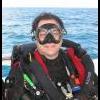
Buoyancy - Trim
#1

Posted 27 August 2006 - 02:20 PM
Skilled, experienced divers, would you please offer tips and tricks on finding/maintaining perfect buoyancy?
(Sept issue Scuba Diver has a good article on this, BTW)
Next, trim, what exactly is trim? How does it differ from buoyancy, proper weighting and finding neutral buoyancy? And are trim pockets really necessary or are they there for looks? Why not just put the weight in the pockets that allow for weight dumping?
#2

Posted 27 August 2006 - 04:47 PM
Achieving neutral bouyancy involves many things from the gear you're using, the suit you're wearing or not wearing, body fat, breathing, steel or aluminum tank, weights and where you carry them, and even the water you're diving in. For every change you make to any of these, there is an adjustment somewhere else. So you can say that an experienced instinctively breathes in such a way as to help maintain neutral bouyancy, but that diver still has to account for his or her diving environment and all the other factors mentioned above when preparing for the dive.From early on, we all are taught that the key to perfect diving is to find and maintain neutral buoyancy. But, constant attention to the inflator hose and BCD release valves is not the answer, is it? Beginner divers may find it necessary to concentrate on buoyancy but experienced divers do it instinctively.
Skilled, experienced divers, would you please offer tips and tricks on finding/maintaining perfect buoyancy?
(Sept issue Scuba Diver has a good article on this, BTW)
Next, trim, what exactly is trim? How does it differ from buoyancy, proper weighting and finding neutral buoyancy? And are trim pockets really necessary or are they there for looks? Why not just put the weight in the pockets that allow for weight dumping?
The more you dive in a certain environment with the same gear configuration, the easier it will be to maintain bouyancy for that environment. Being consistent in that way helped me to concentrate more on breathing technique and reduce the amount of weight I carried - for that environment. The moment I made a change..added a hood, bought a different BC, or even gained a few #'s, I had to make adjustments elsewhere.
Practice, practice, practice, relax, relax, relax, and breath... Find yourself a flat area, platform maybe, and practice just breathing while hovering in one place or doing fin pivots. Don't just use the first 1/3 of your lungs when you breath...breath in deep, let it all out slowly and completely while relaxing...you'll feel yourself raise and lower. Then for grins...take some smaller breaths and let them out gently...you'll move less. NEVER, NEVER take a deep breath and hold it to raise yourself!!! Let the air out slowly, and completely.
Trim is going to determine just how horizontal you are in the water when you're under and whether or not you're face down on the surface. It'll make the difference in whether you're constantly fighting to look up at things, or struggling to keep from plowing up the bottom as you're finning along.
When I changed from a Mares Air Trim BC to a Tusa Selene I had to make major adjustments in my trim. I think the weight pockets on my Selene are more to the front than they were on the air trim. On my safety stops I always ended up upside down. I increased the weight in my trim pockets, reduced what was in my weight pouches and leveled off nicely - but it took at least 8 dives to get it right.
I wish there was a magic equation to be shared; there's not. Even if you do the standard bouyancy check before you descend, doesn't mean you'll be using a proper breathing technique and you may still experience problems. You just have to work at it, considering all the factors that can impact your bouyancy and trim and make one small adjustment at a time until you get to where you need to be. Most importantly...relax and breath.
#3

Posted 27 August 2006 - 07:25 PM
It sounds a lot easier than it is to accomplish. However, almost everyone can master it given time and effort.
"For the diligent diver, closed circuit rebreathers are actually safer than open circuit scuba." Tom Mount
#4

Posted 27 August 2006 - 07:57 PM
Since new divers tend to be overweighted, they are finning while inflating, and the "neutral" they establish is actually only one component of their lift - the other being the propulsion they are unconsciously adding with their feet and sometimes their sculling hands. The extra weight is usually low on the body, so they swim at a 20-45 degree head-up angle. Then, they are in a cycle of purging and adding as they move through the water. When they stop or slow down, they start sinking. They add air, then when they start moving again, they're ascending - air comes out and the cycle repeats.
I try to work with divers to get their weight down to where they are negative enough to offset the loss of air weight at the end of their dive. This reduces the foot-low tendency as well as lowers the energy required to move that weight around, and the amount of air wasted in the cycles I described above.
Like Twinkelz said - practice using both your lungs and your bc to add and release buoyancey - but don't forget to work on overall weight as well.
There is not only an energy penalty for hauling extra weight around, there is a much narrower range your lungs can manage if you are overweighted because of the extra volume of air in your bc required to offset the extra weight.
Edited by Capn Jack, 27 August 2006 - 08:01 PM.
Jacques Yves Cousteau
#5

Posted 27 August 2006 - 10:16 PM
Trim-your body's position in the water coloum.
#6

Posted 21 September 2006 - 10:04 PM
#7

Posted 22 September 2006 - 12:40 PM
During my OW class I had 12 lbs and when we hovered it was like I ws falling backwards due to the weights behind me and the air I had to put in the BC just to get off the bottom. The best example I can give is like when you take training wheels off and run along side a kid while they "think" you're holding on. My instructor had to do this so I would stop trying to right myself and "trust" that it was ok to be practically laying on my back...
Anyway....during the dives this weekend it was like a brand new experience...I could go where I wanted, I could follow my compass without fiding myself the surface or crashing into the bottom. Underwater life was happy!!!!!
that class was so worth it just to get the correct weighting and the time to experiment and focus just on bouyancy...I became more comforatble in those 2 dives than in all of the others yet
#8

Posted 22 September 2006 - 12:46 PM
(My buoyancy sucks so I'm treating myself to some coaching with a buoyancy expert. It's only for 2 and a half days but after reading your report, I'm hoping it will be enough.
#9

Posted 22 September 2006 - 01:04 PM
In terms of weighting, It's surprising how much people overweight themselves. If you sit down and do the math, and a bit of experimenting in a pool, you'll find you are probably carrying FAR too much weight most of the time.
I tried to explain this to a dive friend of mine and finally had to take her in the water. Got my AL80 to 200psi, no weight, 5mm farmer john top, and held a 3ft stop. She couldn't believe it. And I am not a skinny guy by any stretch of the imagination.
Also on the cavern class, I know a lot of people recommend that, but I really don't. If you don't have your buoyancy squared away, you'll be so overwhelmed in a good cavern class, you'll fall behind immediately. You may get the buoyancy part out of it, but you'll miss the rest of the lessons, and the instructor will be stuck with a student who is clearly unprepared to be in an overhead environment.
#10

Posted 22 September 2006 - 01:48 PM
2 days in a pool is usually enough for most people if they have solid instruction. <snip>
Pool, shmool... I'm ocean bound!
BTW, Perrone, my instructor was somewhat horrified when I told her how much weight I needed during my class. We'll see if I manage to whittle it down to something more reasonable.
#11

Posted 22 September 2006 - 02:09 PM
Pool, shmool... I'm ocean bound!
(Well, a few hours in the pool to get accustomed to the BP/W, I hope, and then 2 days in open water.)
If it's adjusted properly, you won't know you have it on in the water. Absolutely diappears. And when you get neutral, you won't know you have any gear on. It all slightly floats off your body. Honestly, I think when it's actually dialed in, and you can hover, I'd swear the entire thing never touches your body. At least I can't feel it.
BTW, Perrone, my instructor was somewhat horrified when I told her how much weight I needed during my class.
I like her already. I was horrified when you told me!
We'll see if I manage to whittle it down to something more reasonable.
Well, the BP/W alone will drop about 8 pounds off you.
#12

Posted 22 September 2006 - 02:23 PM
"For the diligent diver, closed circuit rebreathers are actually safer than open circuit scuba." Tom Mount
#13

Posted 22 September 2006 - 03:11 PM
#14

Posted 22 September 2006 - 05:47 PM
#15

Posted 22 September 2006 - 09:02 PM
A simple test of both is to swim along in nice equilibrium and then stop swimming. If you're properly weighted you'll simply stay where you are. Most (many?) inexperienced divers swim with head up and feet down so some of the effort they're putting in is merely to stay at the same depth. If you work on this for a few dives you'll be surprised how quickly it all comes right. Then later on you can transfer to a CCR and have to unlearn most of what you've learned!
Very nice, thank you!!!
beachbunny@singledivers.com
"Be the change you wish to see in the world"
Ghandi
0 user(s) are reading this topic
0 members, 0 guests, 0 anonymous users


















